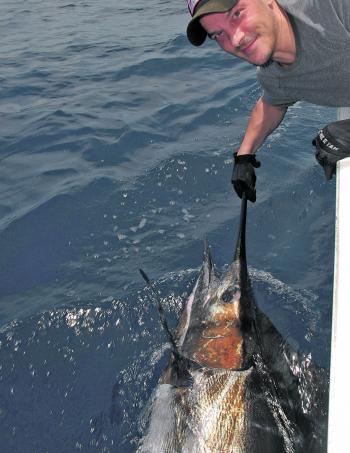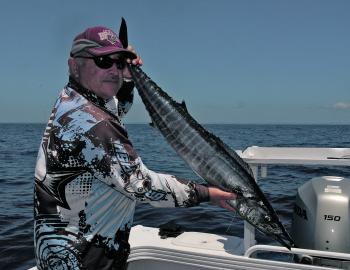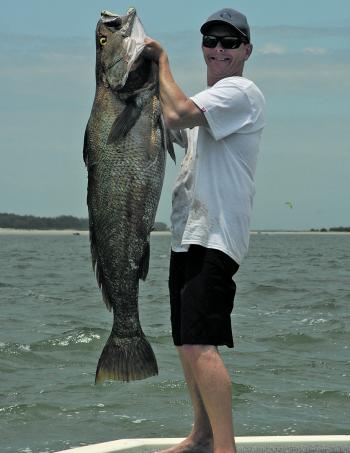The pelagic season so far has been erratic with poor catches on the inshore grounds and a few blue marlin off the edge of the continental shelf. While there have been marlin about, the lack of both mahimahi and wahoo has been quite surprising.
The small black marlin season started late, and while a few fish are now being caught on live baits on the 36 and 42 fathom lines, lure trolling for these great gamefish has been extremely poor and the water quality on the inshore grounds has been poor too. Hopefully in March the season will turn around with at least an increase in wahoo numbers. There have been very few stripies and mack tuna on the inshore grounds.
Out on the shelf the blue marlin fishing has been fairly steady with one or two bites a day. On board Gemma 3 we have caught seven blue marlin from the last seven trips out of 11 bites. These fish have been relatively small, between 100-140kg. Most of our fish have been caught in depths between 200-250m east of the Seaway. In those seven trips we haven’t caught a fish that wasn’t a blue marlin!
When conditions are smooth I find we get most bites on the shotgun and long outrigger line. When it’s a bit rough a lot of bites come on the shorter lines close to the boat. My three best lures so far have been a big Meridian Ahi, a Bahamas Charon 50 and a Fat Boy tube in evil colours (blue and silver skirt over a green and gold skirt).
This month the blue marlin fishing should improve a bit. Closer inshore the mackerel should improve in both size and numbers. So far this year both Palm Beach and Mermaid Reef have produced a mixture of spotted and Spanish mackerel, but it has been quite erratic and the crowds have been very big. Drifting and spinning can be effective, but the best way to chase mackerel when they are shut down is to slowly troll live baits from a downrigger. This works well on the Diamond Reef east of Surfer’s Paradise.
The Tweed Nine Mile is generally worth a fish in March when the weather is good and the current is running. It holds wahoo, mackerel tuna, Spanish mackerel and a few black marlin. I like to drift the area with live baits or troll high-speed metal heads like Hex Heads. If there are small tuna around, they’re the best wahoo bait you can get and slowly trolled around the back ledge of the Nine Mile Reef they can get some amazing bites. There are also some big GTs in this area. Casting stickbaits and poppers is another good option.
Bottom fishing in March is generally quite slow as the current is usually strong and snapper are very scarce on the inshore reefs. There are a few mulloway around the artificial reefs to the north of the Seaway. These fish are quite established now and may be a year-round proposition. These reefs fish best at night.
In March the days get a bit shorter and the water cools down a fraction. At this time quite a few of the adult mangrove jack population start to move into the Seaway area and can be targeted around the rock walls using live baits. Most of these jacks are in the 50-60cm range and at this stage they start to move offshore. As well as mangrove jack, live baits fished in this area produce trevally, mulloway, tailor and big bream. Herrings, yellowtail, poddy mullet and slimy mackerel all work well. Spinning with metal lures on a run in tide in the same area can produce tailor, tarpon and trevally.
Up river there should still be plenty of mangrove jack around the floating pontoons in the Coomera River system, Biggera Creek and the marinas around Hope Island. There is often quite a good surface bite early in the morning in March. Poppers are great to use for Gold Coast jacks. Around the pontoons use 4” paddle-tail plastics and hardbodied minnows. While the upstream jack fishing can slow down a little this month, it’s common to encounter a run of good fish over 50cm in March.
It has been an excellent year for whiting so far with good catches on poppers, small stickbaits and baits. Some good fish over 40cm have turned up in the Nerang River throughout January. This area often fishes well at night, especially on hot days. Beach worms, yabbies, soldier crabs and shrimp all work quite well. Make sure you have an anchor light visible as the Nerang can be quite a busy river at night. The Pimpama River and Coombabah Creek also fish well this month during daylight hours.
March is a very good month for chasing sand and mud crabs. The Pimpama River, Coombabah Creek and Wasp Creek should all hold good numbers of mud crabs this month, particularly if there is a bit of rain. Most of the sand crabs will be in the main part of the Broadwater adjacent to weed beds in 3-5m of water.
Fresh fish frames such as mullet and whiting are ideal for sand crabs. Chicken frames are great mud crab bait and are fairly immune to being eaten out by small fish.
Work your pots on the run in tides and check them every hour. If you aren’t catching quality crabs, vary the depth until you find the best line. This can be critical, especially after a flood.
Overall, March is an interesting month to fish the Gold Coast. While it has been the slowest season for inshore pelagic species in many years, there is hope the fishing will greatly improve this month and there are plenty of options in the estuaries.
Reads: 1350
Chad having a good time showing this marlin the sky.

There are some great stripies on the inshore grounds.

Elliot caught this awesome mulloway that’s more than half his size – what a beast.




